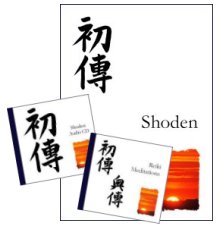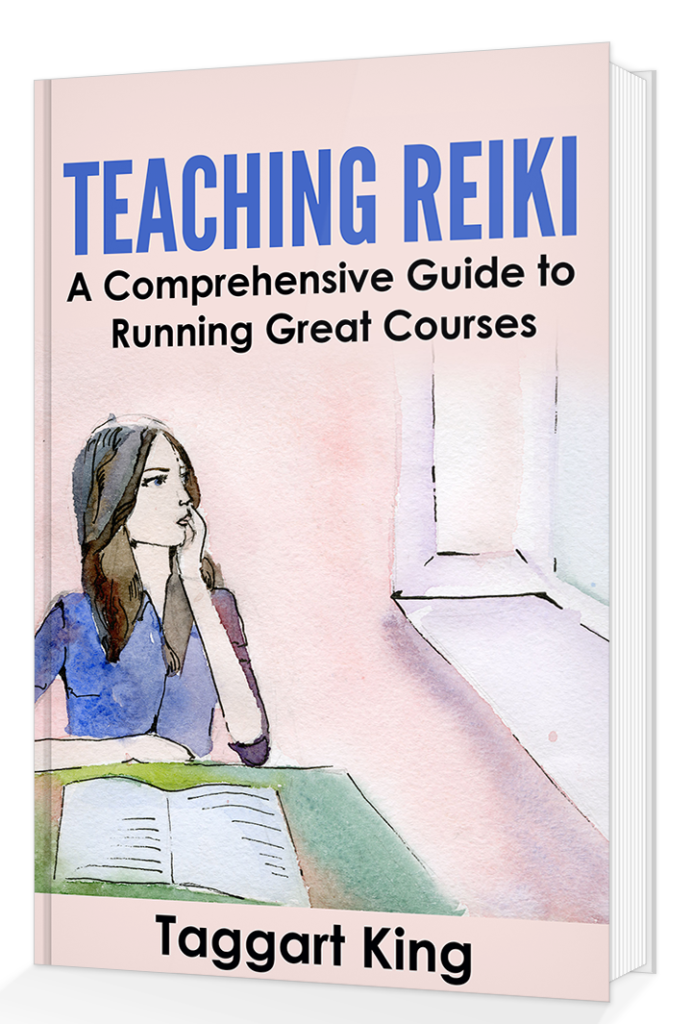
Your students need to relax, safe in the knowledge that everything you say on their Reiki course is covered in detail in their course materials. You should lay out everything that you teach, clearly and logically, with summaries, illustrations or images, and expand on what you teach on the day, providing non-essential but useful information that rounds out and deepens their knowledge of the system that they are learning.
Your students should not be forced to take notes because this is a huge distraction, stops them from enjoying the day, and trying to take decent notes when you’re all zonked out on energy is no fun.
So your students deserve a proper course manual that covers *everything* that you dealt with on the course, with further explanations, examples, and back-up info. They should be able to use your manual as a reference work that they can return to again and again to check on everything that is needed for that level.
You start with your notes
Your Reiki manual should start with what you tell students on their live course, so at the very least they have a hard copy of everything that you say to them, to refer to after their course. They won’t be able to remember, or take notes on, everything that you said to them, after all.
So you can base your manual on the notes that you made when you put your live course together. Write down everything that you think you say to people during your course and that can give you a basic lot of content to work with.
And because your notes will follow the basic order of your course, your manual will also follow that logical structure, which is helpful.
But when you teach, live, you will probably say more than you just jotted down in your notes: you will probably expand on things, give different real-world examples of people that you have treated, for example, to illustrate different points. I would hazard a guess that all of that won’t be there in your notes.
But all these things need to go in your manual, too, to make sure that it is comprehensive and detailed: a true resource for your students to be able to refer to and rely on. So how do you make that happen?
Record yourself when you present your course
Use a hand-held audio recorder to record yourself during your courses. You may not like listening to the sound of your voice but (a lot of people don’t) but you just need to get over yourself and do it anyway(!), because your manual will be so much more useful because of it.
Anything that you explain on a course, that you haven’t already noted down, you should write down now: all the anecdotes, all the explanations, all the descriptions and helpful practical suggestions that you make: add all of these to your manual.
But when we teach Reiki, often new topics of conversation arise. Students come up with so many different questions that you hadn’t prepared for and for which there are no answers in your notes: you have to deal with queries and issues ‘on the fly’, using your knowledge and experience there and then to help your students to be clear about what they should do. This is a very useful resource for you.
Using students’ questions to guide your content
Can you remember what interesting question or questions someone asked you the last time you taught Reiki? Maybe you made a note of them somewhere. You can put those answers or that issue in your manual to make sure that if anyone else wondered about that topic, you already have it covered.
Think back on other courses you held (or even courses that you attended when you were learning Reiki) and see if you can remember what interesting points and issues came up. All these issues can go in your manual.
But maybe you haven’t taught any Reiki courses yet; maybe you are getting your manual together in advance, ready for your first course or courses. That’s ok, because your manual should not be set in stone…
Making your manual a work in progress
Your Reiki manual does not have to be set in stone, a once-in-a-lifetime achievement that is never altered or changed once you have completed it. It would be more useful for you to see it as a work in progress, and manual that is ‘good enough’, but not there quite yet.
So as you carry on teaching Reiki, and have to deal with further interesting questions and queries, or areas where people seem confused or need further explanations to really ‘get it’, you can put all those explanations in your manual, adding to it every few weeks. Over time, you will answer more and more of your students’ questions, each time making your manual more and more comprehensive and useful.
And while we’re talking about making your manual useful, there is something that you can do that will really help your students, which is to…
Give your students options and choices
Now, there is no ‘one true way’ when it comes to Reiki, so suggest different ways that people can do a meditation or a self-treatment or a treatment of someone else. If you do that, you can encourage your students to experiment and find out for themselves what works best for them.
This is a good thing because you are allowing them to develop some flexibility in their approach and giving them ownership of the process.
So explain to them various self-treatment methods, and show how they can treat others in different ways, for example: short blasts on someone’s sore back at work, head/shoulder treatments on someone sitting in a chair, and full treatments on someone lying on a treatment couch.
Using anecdotes, case studies and testimonials
The most powerful way to illustrate and emphasise the main points that you want to get across to your students is to use stories about real people that you have worked with – either whom you have treated or whom you have taught.
So if you are talking about the effects that Reiki can have on people who receive a course of Reiki treatments, illustrate this by talking about the experiences of some of the people that you have treated. You don’t need to identify them by name, but you could say that you treated a lady once who had a problem x and this is what happened.
If one of your clients has given you a testimonial to use, where they talk about what their problem was and how Reiki helped them, you could use that, too, by way of backing up what you are saying.
If you are talking about how being attuned to Reiki can often bring things to the surface to be released, giving students a bit of a rough ride for a while, you could talk about the experiences of someone you have taught, or quote some feedback that they sent you, where they talk about their ‘Reiki cold’ or their emotional ups and downs etc, or where they talk about their sudden desire to de-clutter their house or simplify their life.
Need some help with your course materials?
 I have put together comprehensive and detailed course manuals and easy-to-listen-to audio CDs with commentaries and guided meditations. All these are available for you to use on your own courses (no matter what lineage you have) and you can order them in packs of four at greatly discounted prices.
I have put together comprehensive and detailed course manuals and easy-to-listen-to audio CDs with commentaries and guided meditations. All these are available for you to use on your own courses (no matter what lineage you have) and you can order them in packs of four at greatly discounted prices.
Reiki teachers all over the world are using them.
Find out more by clicking here:
Reiki Evolution Manuals and audio CDs.
Did you like this blog?
If so, you are going to love this book…

“Spot on! I’ve been teaching reiki for many years and I must say I wish this book had landed back then!
I’ve put together courses and really would have loved a book like this to refer back to, it’s concise, clear, laid out really well and is informative and a mini support system to boot.
If you’re entering the Reiki world with an aim to become Master/Teacher then having this book in your armoury will benefit you.”
S J Price
Teaching Reiki
A Comprehensive Guide to Running Great Courses
This is the book I really wish had been available when I started running Reiki courses in 1997. And it would have helped me greatly in my journey as a Reiki teacher thereafter.
You’ll find a wealth of advice about how to set up and run your Reiki courses: read articles about planning and structuring your courses; find out how to explain things to students in a way that honours their learning preferences and personality types; discover how to create top quality course materials and how to support your students long-term.
We look at the differences between ‘Western’ and Original Japanese Reiki and I explain how I created “Reiki Evolution” courses, which pass on the essence of Reiki’s original form. Read this book and you’ll know how to teach “Reiki Evolution” style: what to say, what to teach, and even how to teach Reiki in a ten-week ‘Evening Class’ format.
This book will be of interest to anyone who is about to start teaching Reiki, or to established Reiki teachers who are interested in enhancing the quality of their courses.
Read the contents list before you order, if you like, by clicking on this link: Table of contents
Book: 370 pages.
Price: £15.99 + p&p
Or Download a PDF version now for only £12.49
Save

One thought on “Reiki teaching: How to Create your Reiki manual”